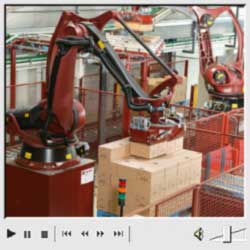|
Starting point / Task
definition
Nestlé Nespresso in Orbe, Switzerland was experiencing
continuous growth, and therefore decided to have a new
production center built. This is now in operation seven
days a week, 24 hours a day, and produces exclusively
Nespresso capsules – of all types, and to meet
the global demand. Since by opening the new factory
the company had quintupled its production capacity,
an efficient palletizing system was required.
Implementation / Solution
Palletizing of the boxes of Nespresso capsules in the
Classic and Professional variants, which each contain
200 and 300 capsules respectively, is now carried out
by three KUKA KR 180 PA palletizing robots. The boxes
are brought on conveyors from the production area to
the robotic cells. There they are held pneumatically
in pickup positions high up off the floor. Previous
to this, a scanner reads the barcodes of the boxes,
a mixture of which is present on the conveyor, thus
enabling the controller to send each type unmixed to
the “correct” robot. The KR 180 PAs pick
up four boxes at a time and stack them on europallets
in accordance with the specified stacking patterns.
The europallets rest on floor-level roller conveyors.
By offsetting the stacking patterns from one layer to
the next, extraordinary stability is achieved.
 The
stacking patterns differ between the Classic and Professional
variants. Classic capsules are stacked by the robots
in five layers per pallet, with 16 boxes per layer:
two rows of six boxes crosswise and one row of four
boxes lengthwise. First the KR 180 PAs set down two
rows of four boxes simultaneously. They then pick four
of them up again, putting them back on the pallet two
at a time in two steps. They then pick up four more
boxes, which they palletize individually. The larger
boxes filled with Professional capsules are set down
by the robots twelve to a layer, and six layers on a
pallet. They begin with two groups of two boxes, followed
by two groups of four. The KR 180 PAs create the desired
stacking patterns by rotating their suction grippers.
Since the vacuum circuits in their end-effectors can
be controlled individually, the robots can hold or set
down any desired number of the four boxes which they
pick up. To handle the empty pallets needed for palletizing,
the KR 180 PAs fold out two hooks on each of the narrow
ends of their grippers. The
stacking patterns differ between the Classic and Professional
variants. Classic capsules are stacked by the robots
in five layers per pallet, with 16 boxes per layer:
two rows of six boxes crosswise and one row of four
boxes lengthwise. First the KR 180 PAs set down two
rows of four boxes simultaneously. They then pick four
of them up again, putting them back on the pallet two
at a time in two steps. They then pick up four more
boxes, which they palletize individually. The larger
boxes filled with Professional capsules are set down
by the robots twelve to a layer, and six layers on a
pallet. They begin with two groups of two boxes, followed
by two groups of four. The KR 180 PAs create the desired
stacking patterns by rotating their suction grippers.
Since the vacuum circuits in their end-effectors can
be controlled individually, the robots can hold or set
down any desired number of the four boxes which they
pick up. To handle the empty pallets needed for palletizing,
the KR 180 PAs fold out two hooks on each of the narrow
ends of their grippers.
Results / Success
Advantages of the “palletizing
expert”
The KR 180 PA “palletizing expert”
is a four-axis robot with a passive fifth axis, whose
application-specific, FEM-optimized kinematic system
guarantees particularly efficient palletizing processes.
Very long reach
The KR 180 PA was chosen above all due
to its long reach. Even though the roller conveyor leading
into the cell is installed about three meters above
floor level, the palletizing experts are able to take
packages from it and to set them down near the floor.
It was thus possible to avoid additional investment
costs for the roller conveyor – thanks to the
KR 180 PAs’ long reach, the conveyor did not have
to be routed downwards.
Availability of nearly 100%
Another advantage of the robots is their
availability of nearly 100%. In order to enhance availability
and thus ensure high throughput, Nestlé Nespresso
has concluded a Service Plus agreement with KUKA Roboter
Schweiz AG. In this contract KUKA is obliged in the
event of a malfunction to dispatch a customer support
technician and the necessary spare parts to the production
center within 24 hours. KUKA Roboter also guarantees
that its own service hotline is available 24 hours a
day, 365 days a year.
Large reserve capacity
At present, Nestlé Nespresso
is using only about 75% of the robots’ capacity;
just two of the KR 180 PAs handle the bulk of the 260
pallets which are loaded each day. The third robot is
primarily intended to prevent bottlenecks in the handling
process when the user expands production capacity in
the future.
|
